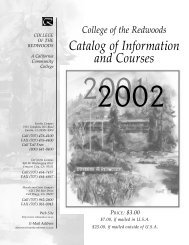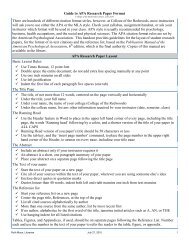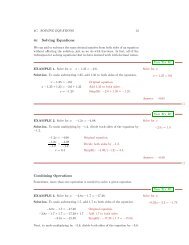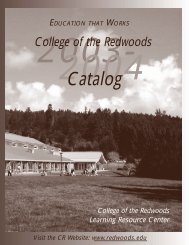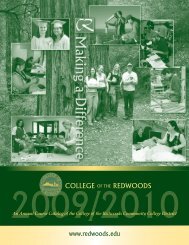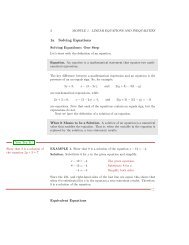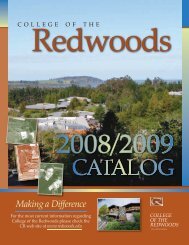2010-2011 Catalog (PDF) - College of the Redwoods
2010-2011 Catalog (PDF) - College of the Redwoods
2010-2011 Catalog (PDF) - College of the Redwoods
You also want an ePaper? Increase the reach of your titles
YUMPU automatically turns print PDFs into web optimized ePapers that Google loves.
programs <strong>of</strong> study<br />
COLLEGE OF THE REDWOODS<br />
<strong>2010</strong>-<strong>2011</strong> CATALOG<br />
Transfer Requirements<br />
For students wishing to pursue a bachelor’s (four-year)<br />
degree, <strong>College</strong> <strong>of</strong> <strong>the</strong> <strong>Redwoods</strong> <strong>of</strong>fers <strong>the</strong> first two years<br />
<strong>of</strong> most four-year degree programs. In addition, students<br />
may make up any high school grade or subject deficiencies<br />
which are required for entrance to four-year colleges or<br />
universities.<br />
Requirements <strong>of</strong> various college and universities will<br />
vary — no two state colleges or branches <strong>of</strong> a university<br />
will necessarily have <strong>the</strong> same requirements. Students,<br />
<strong>the</strong>refore, should secure a copy <strong>of</strong> <strong>the</strong> appropriate college<br />
or university catalog and work closely with <strong>the</strong>ir advisor or<br />
counselor in planning <strong>the</strong>ir program.<br />
Transfer Agreements with <strong>College</strong>s and Universities<br />
<strong>College</strong> <strong>of</strong> <strong>the</strong> <strong>Redwoods</strong> negotiates agreements with<br />
a number <strong>of</strong> colleges and universities whereby, <strong>the</strong>se<br />
institutions guarantee that <strong>the</strong>y will accept certain <strong>College</strong><br />
<strong>of</strong> <strong>the</strong> <strong>Redwoods</strong> courses as fulfilling specific lower<br />
division requirements in various major fields. These<br />
transfer agreements are also referred to as ‘Articulation<br />
Agreements.’ Transfer information for many <strong>of</strong> <strong>College</strong> <strong>of</strong><br />
<strong>the</strong> <strong>Redwoods</strong> programs may be obtained at www.assist.<br />
org. Assist is <strong>the</strong> statewide articulation site designed to be<br />
used by counselors and students to determine equivalent<br />
course work and requirements at o<strong>the</strong>r California public<br />
colleges and universities.<br />
Lower Division Transfer Patterns (LDTP)<br />
The Lower Division Transfer Patterns (LDTP) is a program<br />
sponsored by <strong>the</strong> California State University (CSU) and<br />
supported by <strong>the</strong> California Community <strong>College</strong>s that presents<br />
potential transfer students with <strong>the</strong> most direct path to<br />
a bachelor’s degree in <strong>the</strong> CSU system. The ultimate goal<br />
<strong>of</strong> <strong>the</strong> LDTP is to identify a set <strong>of</strong> “road maps” for students<br />
to follow that will increase <strong>the</strong>ir academic preparation and<br />
decrease <strong>the</strong>ir time to graduate once <strong>the</strong>y enter <strong>the</strong> CSU.<br />
Students who elect to follow <strong>the</strong> LDTP option will receive<br />
<strong>the</strong> highest priority for admission to a CSU campus.<br />
Highest priority for admission is defined as a written guarantee<br />
that is granted at <strong>the</strong> time <strong>the</strong> student accepts <strong>the</strong><br />
<strong>of</strong>fer <strong>of</strong> <strong>the</strong> LDTP agreement from a specific CSU campus<br />
subject to satisfactory completion <strong>of</strong> <strong>the</strong> requirements <strong>of</strong><br />
<strong>the</strong> agreement between <strong>the</strong> student and <strong>the</strong> CSU. Students<br />
will be asked to complete a distinct set <strong>of</strong> general education<br />
and major courses which are common to all CSU campuses<br />
and identify a major program with a CSU campus once<br />
<strong>the</strong>y have completed 45 transferable units.<br />
In addition, students will complete a set <strong>of</strong> major courses<br />
specific to <strong>the</strong> campus <strong>the</strong>y select to meet <strong>the</strong> required<br />
60 units needed to transfer to CSU as an upper division<br />
transfer student.<br />
Through CSU Mentor (http://www.csumentor.edu/), counselors<br />
and students will be able to obtain more information<br />
regarding <strong>the</strong> process <strong>of</strong> entering into an LDTP for a specific<br />
campus and major, “road maps” detailing coursework by<br />
campus and major, and a transfer planner for students to<br />
track <strong>the</strong>ir progress through <strong>the</strong> LDTP program.<br />
<strong>College</strong> <strong>of</strong> <strong>the</strong> <strong>Redwoods</strong> - Making A Difference<br />
37




